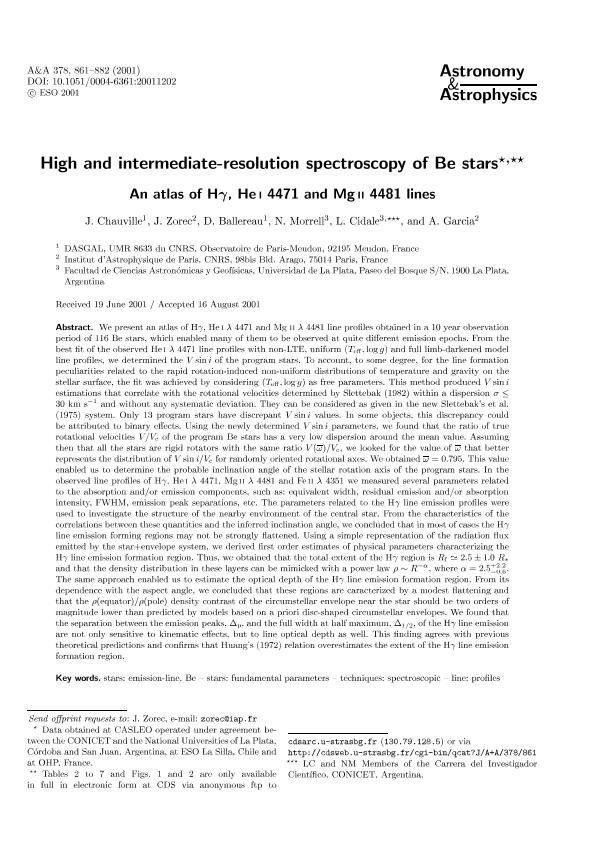Mostrar el registro sencillo del ítem
dc.contributor.author
Chauville, J.

dc.contributor.author
Zorec, J.
dc.contributor.author
Ballereau, D.

dc.contributor.author
Morrell, Nidia Irene

dc.contributor.author
Cidale, Lydia Sonia

dc.contributor.author
Garcia, A.
dc.date.available
2018-02-22T15:03:07Z
dc.date.issued
2001-11
dc.identifier.citation
Chauville, J.; Zorec, J.; Ballereau, D.; Morrell, Nidia Irene; Cidale, Lydia Sonia; et al.; High and intermediate-resolution spectroscopy of Be stars : an atlas of Hg, He I 4471 and Mg II 4481 lines; EDP Sciences; Astronomy and Astrophysics; 378; 11-2001; 861-882
dc.identifier.issn
0004-6361
dc.identifier.uri
http://hdl.handle.net/11336/36962
dc.description.abstract
We present an atlas of Hγ, He i λ 4471 and Mg ii λ 4481 line profiles obtained in a 10 year observation period of 116 Be stars, which enabled many of them to be observed at quite different emission epochs. From the best fit of the observed He i λ 4471 line profiles with non-LTE, uniform (Teff , log g) and full limb-darkened model line profiles, we determined the V sin i of the program stars. To account, to some degree, for the line formation peculiarities related to the rapid rotation-induced non-uniform distributions of temperature and gravity on the stellar surface, the fit was achieved by considering (Teff, log g) as free parameters. This method produced V sin i estimations that correlate with the rotational velocities determined by Slettebak (1982) within a dispersion σ ≤ 30 km s−1 and without any systematic deviation. They can be considered as given in the new Slettebak’s et al. (1975) system. Only 13 program stars have discrepant V sin i values. In some objects, this discrepancy could be attributed to binary effects. Using the newly determined V sin i parameters, we found that the ratio of true rotational velocities V /Vc of the program Be stars has a very low dispersion around the mean value. Assuming then that all the stars are rigid rotators with the same ratio V (ω)/Vc, we looked for the value of ω that better represents the distribution of V sin i/Vc for randomly oriented rotational axes. We obtained ω = 0.795. This value enabled us to determine the probable inclination angle of the stellar rotation axis of the program stars. In the observed line profiles of Hγ, He i λ 4471, Mg ii λ 4481 and Fe ii λ 4351 we measured several parameters related to the absorption and/or emission components, such as: equivalent width, residual emission and/or absorption intensity, FWHM, emission peak separations, etc. The parameters related to the Hγ line emission profiles were used to investigate the structure of the nearby environment of the central star. From the characteristics of the correlations between these quantities and the inferred inclination angle, we concluded that in most of cases the Hγ line emission forming regions may not be strongly flattened. Using a simple representation of the radiation flux emitted by the star+envelope system, we derived first order estimates of physical parameters characterizing the Hγ line emission formation region. Thus, we obtained that the total extent of the Hγ region is Rf ' 2.5 ± 1.0 R∗ and that the density distribution in these layers can be mimicked with a power law ρ ∼ R−α, where α = 2.5+2.2 −0.6. The same approach enabled us to estimate the optical depth of the Hγ line emission formation region. From its dependence with the aspect angle, we concluded that these regions are caracterized by a modest flattening and that the ρ(equator)/ρ(pole) density contrast of the circumstellar envelope near the star should be two orders of magnitude lower than predicted by models based on a priori disc-shaped circumstellar envelopes. We found that the separation between the emission peaks, ∆p, and the full width at half maximum, ∆1/2, of the Hγ line emission are not only sensitive to kinematic effects, but to line optical depth as well. This finding agrees with previous theoretical predictions and confirms that Huang’s (1972) relation overestimates the extent of the Hγ line emission formation region.
dc.format
application/pdf
dc.language.iso
eng
dc.publisher
EDP Sciences

dc.rights
info:eu-repo/semantics/openAccess
dc.rights.uri
https://creativecommons.org/licenses/by-nc-sa/2.5/ar/
dc.subject
Emission Lines
dc.subject
Fundamental Parameters
dc.subject
Spectroscopic Techniques
dc.subject
Line Profiles
dc.subject
B[E] Stars
dc.subject.classification
Astronomía

dc.subject.classification
Ciencias Físicas

dc.subject.classification
CIENCIAS NATURALES Y EXACTAS

dc.title
High and intermediate-resolution spectroscopy of Be stars : an atlas of Hg, He I 4471 and Mg II 4481 lines
dc.type
info:eu-repo/semantics/article
dc.type
info:ar-repo/semantics/artículo
dc.type
info:eu-repo/semantics/publishedVersion
dc.date.updated
2018-02-19T16:54:26Z
dc.journal.volume
378
dc.journal.pagination
861-882
dc.journal.pais
Francia

dc.journal.ciudad
Les Ulis Cedex - Francia
dc.description.fil
Fil: Chauville, J.. Observatoire de Paris-Meudon; Francia
dc.description.fil
Fil: Zorec, J.. Institut d’Astrophysique de Paris; Francia
dc.description.fil
Fil: Ballereau, D.. Observatoire de Paris-Meudon; Francia
dc.description.fil
Fil: Morrell, Nidia Irene. Universidad Nacional de la Plata. Facultad de Ciencias Astronómicas y Geofísicas; Argentina
dc.description.fil
Fil: Cidale, Lydia Sonia. Universidad Nacional de la Plata. Facultad de Ciencias Astronómicas y Geofísicas; Argentina. Consejo Nacional de Investigaciones Científicas y Técnicas. Centro Científico Tecnológico Conicet - La Plata. Instituto de Astrofísica La Plata. Universidad Nacional de La Plata. Facultad de Ciencias Astronómicas y Geofísicas. Instituto de Astrofísica la Plata; Argentina
dc.description.fil
Fil: Garcia, A.. Institut d’Astrophysique de Paris; Francia
dc.journal.title
Astronomy and Astrophysics

dc.relation.alternativeid
info:eu-repo/semantics/altIdentifier/url/http://adsabs.harvard.edu/abs/2001A%26A...378..861C
dc.relation.alternativeid
info:eu-repo/semantics/altIdentifier/doi/http://dx.doi.org/10.1051/0004-6361:20011202
Archivos asociados
